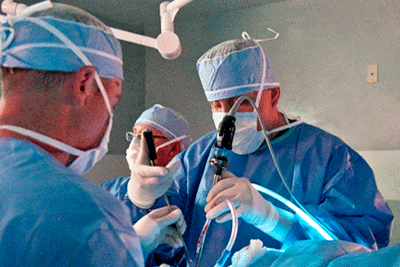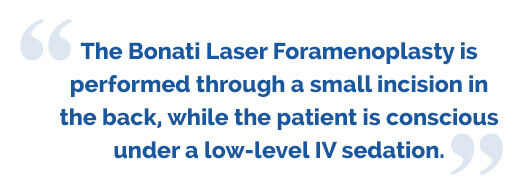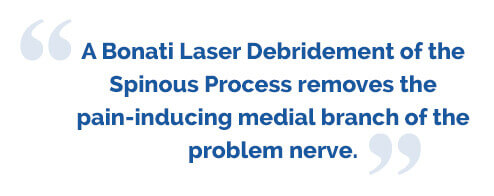Lumbar Spine Surgery
Lumbar spine surgery is required when conditions such as sciatica, herniated disc, spinal stenosis, etc., cause symptoms have have not responded to conservative treatment. The lumbar spine refers to the lower back between the rib cage and pelvis. There are five vertebrae in the lumbar spine, L1 – L5, and they are considered the largest segments in the vertebral column. These vertebrae must support the weight of the entire torso and absorb the stress of lifting or carrying heavy objects.
The lumbar spine connects with the sacrum at L5-S1. This joint allows the body to rotate when walking and running.

Lumbar Spine Surgery at The Bonati Spine Institute
Conditions That May Require Lumbar Spine Surgery
As the lumbar spine must bear the weight of the entire body as well as help with running, walking, lifting and carrying, it is often the most common location of pain and injury. An estimated 80 percent of people will experience back pain at one point in their life. Low back pain is the most common cause of job-related disability and the most common reason for missed days of work.
Some common conditions that can require lumbar spine surgery include:
• Sciatica
Traumatic injuries are one of the most common causes of low back pain, and in some cases, the injuries can also lead to more severe spinal conditions.
Symptoms of Lumbar Spinal Conditions
The following symptoms may be indicative of a spinal condition that requires lumbar spinal surgery:
• Severe pain in the lower back
• Numbness
• Tingling that radiates into other areas of the lower body
• Muscle spasms
• Burning low back pain
• Weakness in the lower extremities
• Sensory loss
• Pain made worse when coughing or laughing
• Loss of bowel/bladder control
Diagnosing Lower Back Pain
A complete medical history and physical examination can often identify serious conditions that may be causing the pain. A doctor may ask about the onset of the pain, where you feel the pain the most and the severity. A physical examination can help determine if your movement is limited.
Imaging tests are not always completed, but they are often recommended as they can reveal a serious spinal condition. Computerized tomography (CT), X-rays and/or Magnetic resonance imaging (MRI) are the most common forms of imaging studies performed.
Who Is a Candidate for Surgery?
Determining if you are a candidate for surgery will involve a review of your medical history, physical examination and a thorough analysis of your imaging studies.
You may be a candidate if:
• You’re experiencing significant pain, weakness or numbness
• Your symptoms have not improved with physical therapy, medication and other conservative treatments
• Diagnostic studies show a treatable spinal condition
• You are in otherwise good health
If you believe you may be a candidate for lumbar spinal surgery, contact The Bonati Spine Institute at 855-267-0482.
Conservative Treatment and Non-surgical Alternatives
If you are suffering from back pain, surgery is not usually the first option. There are many alternatives to surgery that could help alleviate the lower back pain.
Some alternatives can include:
• Massage therapy
• Lumbar Epidural Steroid Injections
• Acupuncture
• Chiropractic therapy
• Yoga and exercising
• Non-steroidal anti-inflammatory medications
For some, these alternatives may help to provide a reprieve from back pain. However, if the symptoms have persisted and these conservative treatment options have not resolved the problem, surgery may be required.
Options for Lumbar Spinal Surgery
An estimated 600,000 Americans undergo back surgery every year. A lot of these surgeries involve spinal fusions, which are highly invasive and have a high failure rate. Many others are done via the traditional open spine surgery with all its associated risks and complications.
History of Lumber Spine Surgery
One of the first instances of spine surgery was in 1829 when A.G. Smith performed a laminectomy. Thirty years later, Rudolf Virchow published a discussion that included information on a ruptured disc. In 1864, Ernest Lasegue commented on the physical signs of a patient with sciatic neuritis, the inflammation of the sciatic nerve.
In 1909, Fedor Krause was the first to successfully remove a ruptured disc. During the procedure, he made a low lumbar midline incision and reflected the muscles from the laminae, which were then removed in one piece. That same year, Alfred Taylor performed the first unilateral laminectomy in the lumbar and sacral; it was performed on a cadaver.
In 1933, William Jason Mixter and Joseph S. Barr presented surgical findings at the Annual Meeting of the New England Surgical Society. The duo asserted that a ruptured invertebral disc could lead to serious symptoms and surgical decompression was a preferred treatment. Following the publication of these findings in 1934, lumbar discectomies through open back surgeries become much more common and were carried out by neurosurgeons.
Advancements in Surgery
More than 80 years later, the use of imaging tests, advanced surgical techniques, and technological developments have changed lumbar spinal procedures. But still, the only options were highly invasive open spine surgery or spinal fusions. Because of the high failure rate of these procedures, many patients were recommended to avoid back surgery altogether, and either live with the pain or temporarily mask it with narcotics. Some common complications of spinal fusion and open back surgery include:
• Anesthesia Complications
• Failed Back Surgery Syndrome
• Scar Tissue Formation
• Hardware Fraction and Implant Migration
• Pseudoarthrosis
Over 30 years ago, Dr. Bonati, pioneered advanced outpatient spine surgery, today known as The Bonati Spine Procedures. The Bonati Spine Procedures have revolutionized spinal care. This evolution in spine surgery has changed the equation, to the point that you should not learn to live with the pain but rather address those problems as early as possible so you can live your life to the fullest.
Over the years, physicians of The Bonati Spine Institute have perfected the exclusive Bonati Spine Procedures, allowing us to perform the world’s most advanced spine surgery procedures. This dedication to innovation is what makes the Bonati Spine Institute the worldwide leader in advanced spine surgery.
The Bonati Spine Procedures
The Bonati Spine procedures are a proven and effective alternative to invasive lumbar spinal procedures that may not yield the results for patients
The Bonati Spine Procedures offer an array of procedures for treating lumbar spine problems including:
Discectomy – involves removing a portion of the affected vertebral disc to relieve pressure on the nerve roots
Foraminotomy/Foraminectomy – Involves removing bone or tissue that is obstructing the passageway of the nerves and compressing the nerve roots
Laminotomy/Laminectomy: Involves creating space by removing part of the lamina, thus, creating more room for the nerve.
The Bonati Spine Discectomy
The Bonati Laser Discectomy of the Lumbar Spine is performed through a small incision, with the patient awake but comfortable under local anesthesia and IV sedation. Using specially adapted instruments the diseased disc material is removed and a laser vaporizes the surrounding problem tissue. The laser is then used to shrink and remodel the remaining disc. A small dressing is used to cover the incision. Herniated lumbar discs that produce back and leg pain can be treated with this procedure. The portion of the disc that is causing nerve compression can effectively be removed through the small incision. Often patients feel immediate relief following this procedure. Rehabilitation begins within hours of surgery, and involves gait training, lumbar support, and walking.

The benefits of this procedure include:
• Fewer risks, local anesthesia, a small incision
• Minimal blood loss
• Short recuperation time
• Minimal damage to tissues
• Surgeries are done in an outpatient setting
• Patient sees a faster return to a normal lifestyle
The Bonati Lumbar Facet Debridement
This procedure is designed to help people with:
• Severe lower back pain that may radiate into the buttocks
• Pain that has not responded to conventional treatments such as rest, analgesics, anti-inflammatories, muscle relaxants and physical therapy
• Pain from Degenerative Joint Disease confirmed by X-rays
• Pain from previously failed surgeries with persistent back/buttock pain
Facet joints, which connect bones in the spine, facilitate motion. Each vertebra has two sets of facet joints, with one pair facing upward and one downward. The joints, which are located at the back of the spine, are like hinges that link the vertebrae together. Debridement means the surgical removal of torn, inflamed, contaminated, damaged or dead tissue.

This technique is used to treat painful facet joints. Prior to surgery, a diagnostic injection of Lidocaine is used to confirm this condition as the cause of lumbar pain. This surgical procedure uses specially designed probes and the Holmium YAG Laser to remove pain-inducing tissue in nerve branches above and below the affected facet joints on the spine. This procedure is performed by numbing the skin with local anesthesia and inserting a small tube down through a small incision. A miniaturized fiber optic camera is used to visualize the passageway and the exact problem area. Using a laser, the surgeon vaporizes the painful nerves around the diseased area. Most patients experience relief with a short recovery time. A Bonati Laser Lumbar Facet Debridement usually takes less than 30 minutes and many patients feel immediate relief following this procedure.
The benefits of this procedure include:
• Fewer risks, local anesthesia, a small incision
• Minimal blood loss
• Short recuperation time
• Minimal damage to tissues
• Surgeries are done in an outpatient setting
• Patient sees a faster return to a normal lifestyle
The Bonati Foraminotomy/Foraminectomy of the Lumbar Spine
A foramen is a window through which a nerve root exits the spine. Bone spurs that form as a result of Degenerative Disc Disease or spinal arthritis may narrow the foramen causing spinal stenosis or foraminal stenosis, conditions that typically cause leg pain. Also, a foramen may be narrowed by a herniated disc or scar tissue from previous surgery. These problems can be treated by a Bonati Foraminotomy/Foraminectomy of the Lumbar Spine.

The Bonati Foraminotomy/Foraminectomy of the Lumbar Spine is performed through a small incision in the back, while the patient is conscious under a low-level IV sedation. The narrowed foramen is located with fluoroscopic x-rays, and a guide wire is placed down to the area of disease. Then, a hollow dilating tube is inserted over the wire to the foramen. The endoscope and related surgical instruments are inserted through the tube, which provide direct visualization of scar tissue, bone spurs, and diseased disc material. During this procedure the surgeons utilize specialized instrumentations to decompress the nerve roots as they exit through the foramen.
The benefits of this procedure include:
• Fewer risks, local anesthesia, a small incision
• Minimal blood loss
• Short recuperation time
• Minimal damage to tissues
• Surgeries are done in an outpatient setting
• Patient sees a faster return to a normal lifestyle
The Bonati Debridement of the Lumbar Spinous Process
This procedure is designed to help people with:
• Severe pain along the back of the spine that radiates to other parts of the body
• Pain that has not responded to conventional treatments such as rest, analgesics, anti-inflammatories, muscle relaxants, and physical therapy
• Severe pain along the back of the spine that is temporarily relieved with Xylocaine
• Previously failed surgeries with local spinous process pain

The spinous process is the portion of the vertebrae that protrudes from the back of the spinal column. Spinous processes create the “bumps” on the midline of the back. A Bonati Laser Debridement of the Spinous Process removes the pain-inducing medial branch of the problem nerve. Using local and IV anesthesia and X-rays for guidance, specially designed instruments are inserted directly over the affected spinous process. The laser is then used to obliterate the medial branch of the spinal nerve.
The benefits of this procedure include:
• Fewer risks, local anesthesia, a small incision
• Minimal blood loss
• Short recuperation time
• Minimal damage to tissues
• Surgeries are done in an outpatient setting
• Patient sees a faster return to a normal lifestyle
Before and After Surgery
Before surgery, you may be required to have blood work completed and will be asked to stop taking any non-steroidal anti-inflammatory medicines, blood thinners, drugs that contain aspirin and any vitamins and herbal supplements. You should stop smoking and drinking before surgery as well.
You’ll be required to have a companion who can drive you and stay with you after surgery. Comfortable, loose clothing is also suggested post-surgery.
The Bonati Spine procedures are outpatient surgeries, which means you will not have to stay overnight at a hospital. Following the surgery, your surgeon will have a post-op follow-up to ensure the procedure went well and to determine if you require any further procedures. You will also be given a walking regimen so you can stay active.
You may need help with daily activities, such as dressing, for the first few days. It is important to follow all the post-op incision care and recovery recommendations.
